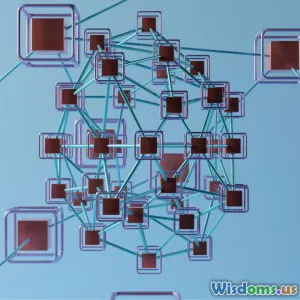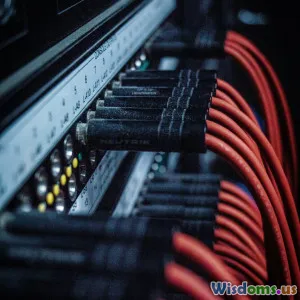
Can Proper Subnetting Prevent Network Congestion
12 min read Explore how proper subnetting can minimize network congestion and optimize performance in modern IT environments. (0 Reviews)
Can Proper Subnetting Prevent Network Congestion?
Today's digital businesses hinge on reliable and fast communication. As networks scale up to accommodate more users and devices, managing data flow becomes crucial. A common technical consideration for network quality is subnetting—the process of dividing a network into smaller, manageable segments. Can effective subnetting actually help prevent network congestion? This article explores the parallels between smart subnetting strategies and improved traffic flow, unpacking their impact through real-world scenarios and actionable insights.
Demystifying Network Congestion

Network congestion evokes images similar to rush-hour traffic gridlocks: data packets pile up at bottlenecks, waiting to proceed along crowded paths. Congestion manifests as slower connection speeds, dropped packets, or even outages. Several root causes exist, such as:
- Excessive simultaneous device communication
- Insufficient bandwidth allocation
- Broadcast storms from poorly segmented networks
An infamous real-world example is the periodic slowdown on campus networks during streaming-heavy periods—think of lecture halls as single massive networks where every student's stream collides, overloading the shared data 'roadways.'
Subnetting: More Than Just Slicing Address Space

Subnetting is the method of dividing a physical network into several smaller logical networks or subnets. Each subnet operates semi-independently within the parent network.
The primary goal is often to manage IP address allocation, but the advantages are far-reaching:
- Improved segmentation of broadcast domains: Prevents extraneous traffic from overwhelming nodes.
- Enhanced security controls: Isolates user groups.
- Better traffic management: Directs local traffic within confines.
For instance, a business campus might partition finance, HR, and R&D departments onto separate subnets, ensuring the broadcast storms from one don’t flood others.
How Subnetting Affects Network Traffic

When a large number of endpoints share a single subnet, all devices see every broadcast packet, regardless of their relevance. This overhead escalates dramatically as the network grows.
Imagine a scenario with one large, flat subnet supporting 800 workstations. If every device issues regular broadcast requests (e.g., for address discovery or ARP), network devices become swamped, generating delays and potential collisions. As an antidote, effective subnetting reduces the broadcast domain, chopping a single massive zone into smaller, manageable pieces. This division means only local traffic is handled within each subnet, sharply lowering unnecessary packet propagation.
A practical illustration comes from a medium-sized accounting firm that restructured its network into one subnet per floor. After this change, internal reports showed an over 30% decrease in broadcast traffic volume and measurable improvements in the response time for cloud applications.
Techniques to Apply Proper Subnetting

To harness the network congestion mitigation benefits, technical teams need to focus on subnet design. Here are actionable steps:
1. Assess Network Usage Patterns
Note which devices communicate most frequently and the types of services required. For example:
- Desktops and printers within a department
- Real-time services (VoIP phones)
Grouping devices that communicate regularly onto the same subnet reduces the necessity for traffic to cross routers, limiting congestion at interconnection points.
2. Apply Hierarchical Subnetting
Break down the address space into logical layers, aligning with organizational structures (e.g., by department, function, or location). Using Variable Length Subnet Masks (VLSM) allows for customized allocation—assigning just enough IP space per group, leaving room for future growth.
Example:
If you manage a /22 block (1024 possible addresses) for an office, you could segment:
- /25 for executives (126 hosts)
- /24 for general staff (254 hosts)
- /26 for conference rooms (62 hosts)
3. Maintain Scalability and Avoid Fragmentation
Subnetting too aggressively creates administrative overwhelm and inefficient IP utilization. Conversely, oversize subnets do little to curb congestion. Balancing needs with headroom for future expansion is key.
4. Employ Tools
Subnet calculators and visualization software (like SolarWinds IP Address Manager) can translate complex planning into easily actionable IP address schemes, minimizing error risks and ensuring consistent network segmentation.
Subnetting and Network Devices: Routers, Switches, and Firewalls

Subnetting’s influence touches key network hardware:
- Routers use subnets to determine logical boundaries and optimize packet forwarding. They also contain broadcast traffic within subnets.
- Switches forward traffic within subnets efficiently, minimizing delay due to fewer unnecessary broadcasts.
- Firewalls leverage subnets for access control, enabling more granular rule application and reducing the chances of harmful congestion from unauthorized surges.
For example, consider a cloud datacenter architecture where each customer environment is placed into an isolated subnet, with dedicated routers and next-generation firewalls controlling east-west (inter-service) and north-south (external/internal) data flows. This segmentation forms guarded lanes for traffic, akin to toll booths and dedicated express lanes on physical highways.
Subnetting vs. VLANs: Similarities and Differences

While both subnetting and Virtual Local Area Networks (VLANs) partition networks, their focus and implementation differ:
- Subnetting operates at Layer 3 (network layer), dictating IP addressing and routing decisions.
- VLANs function at Layer 2 (data link), segregating broadcast domains on the same physical infrastructure.
Organizations often use VLANs for grouping devices regardless of physical topology, whereas subnetting typically aligns IP addressing schemes to logical or departmental constructs.
Tip: Combining VLANs with subnetting provides the strongest isolation and traffic control. For example, merged policies can keep all guest WiFi users segregated both by IP (subnet) and switch traffic (VLAN), insulating internal resources from accidental or malicious congestion.
Real World Case Study: University Campus Network Redesign

A major university IT department noticed spikes in downtime and data bottlenecks during semester starts. Initially, they ran an oversized flat network spanning dorms, labs, administration, and teaching halls, divided only by building.
After consults and data analysis, they:
- Mapped user density and traffic volume
- Created separate subnets for key zones: housing, research labs (with heavy data use), admin offices, and event venues
- Introduced VLANs layered atop these subnets by department and security level
Results included:
- Network congestion on registration and exam days dropped by over 40%
- Security incidents involving lateral traffic declined
- IT support tickets citing 'slow network' fell by half within a year
This comprehensive partitioning allowed broadcast storms or malware outbreaks to remain isolated, minimizing impact on the rest of the campus.
Top Tips for Preventing Congestion Through Subnetting

Drawing from industry best practices and field experience, here is a shortlist for network managers:
- Audit Regularly: Attack patterns, application requirements, and device growth dictate periodic subnet review.
- Automate Management: Use dynamic addressing protocols (like DHCP scopes aligned with subnets) to make IP churn less error-prone.
- Document Everything: Precise network maps and addressing plans ensure seamless handovers and troubleshooting.
- Plan for Redundancy: Design alternate paths and peer relationships between subnets for business continuity during congestion spikes or outages.
- Educate Users: Inform staff about data-intensive actions and how their network behavior affects congestion.
The Future: Subnetting in Next-Gen Networks

Emerging trends such as Software Defined Networking (SDN) and AI-driven traffic optimization are redefining how subnetting will operate. In programmable networks, subnet boundaries become flexible—SDN controllers can reallocate address space, or spin up micro-segments for critical workloads on demand, throttling or isolating errant hosts instantly.
Telecom and hyperscale cloud providers now leverage adaptive (intent-based) subnetting, where analytics identify impending congestion and preemptively reshape subnets and IP pools before users experience slowdowns, keeping traffic flowing smoothly 24/7.
Proper subnetting won’t solve every network congestion problem, nor is it a one-size-fits-all remedy. However, it’s a linchpin in the toolbox for designing scalable, resilient, and high-performance networks. By segmenting with intention—balancing broadcast control, ip address optimization, and logical grouping—organizations dramatically reduce opportunities for network bottlenecks. Combined with evolving technologies such as VLANs, SDN and real-time analytics, subnetting remains a timeless strategy, separating digital traffic into the fast lanes that modern infrastructure demands.
Rate the Post
User Reviews
Popular Posts
















